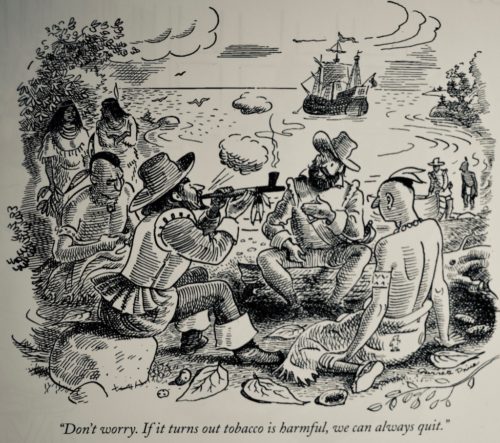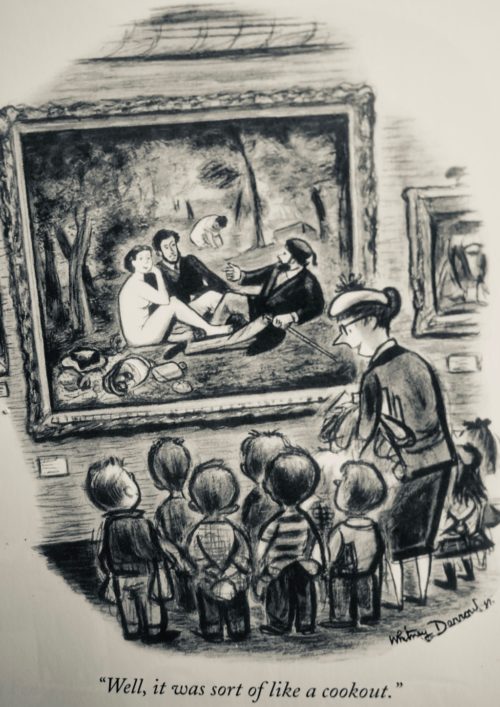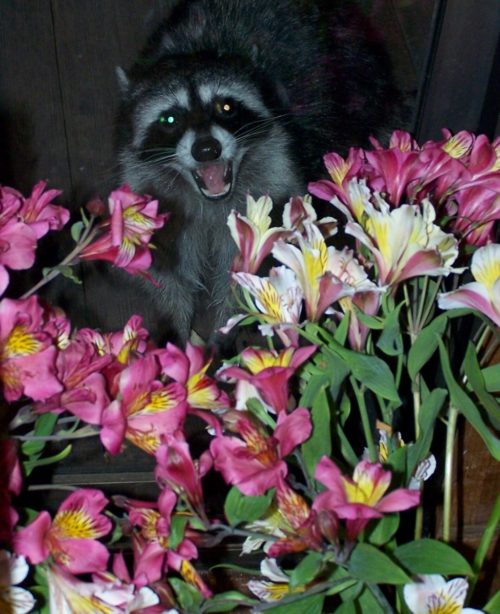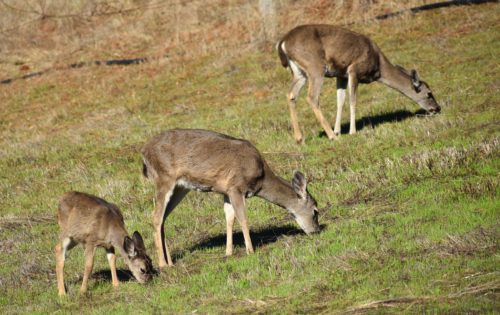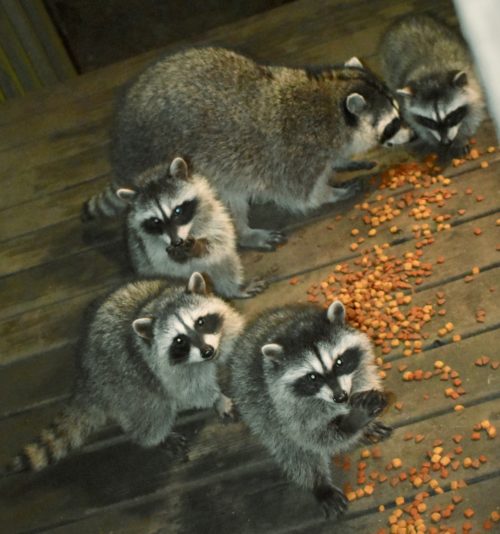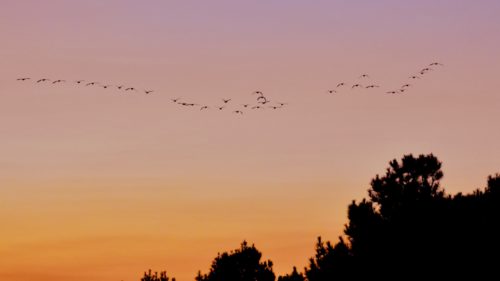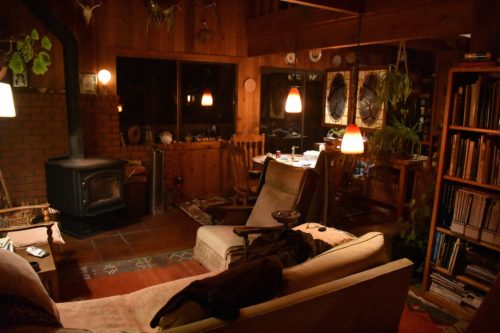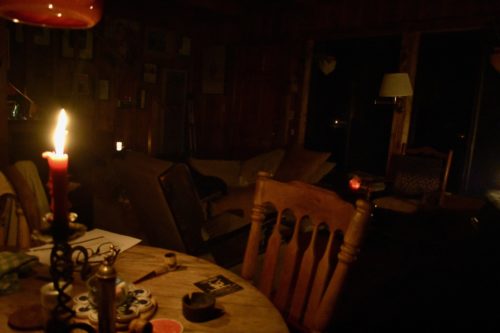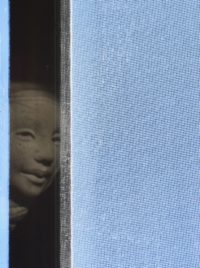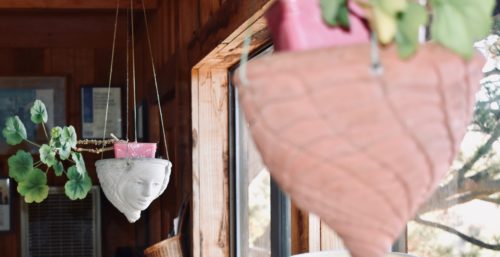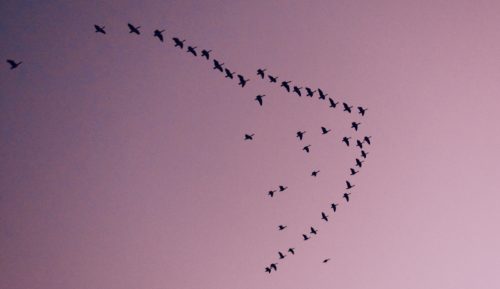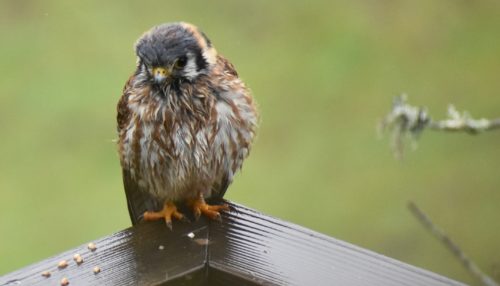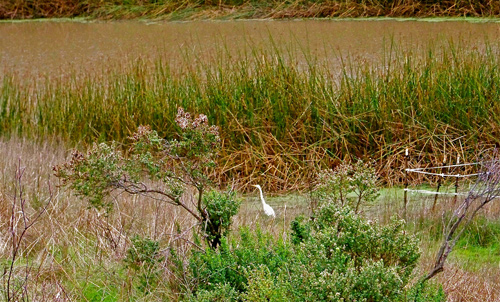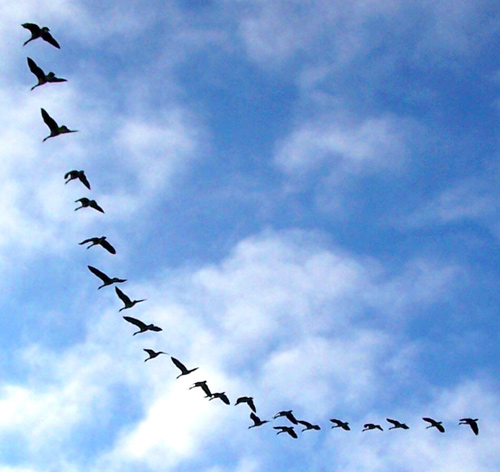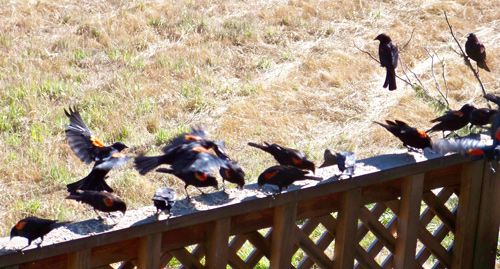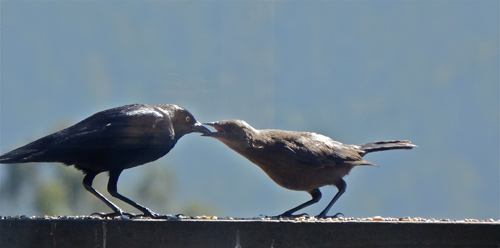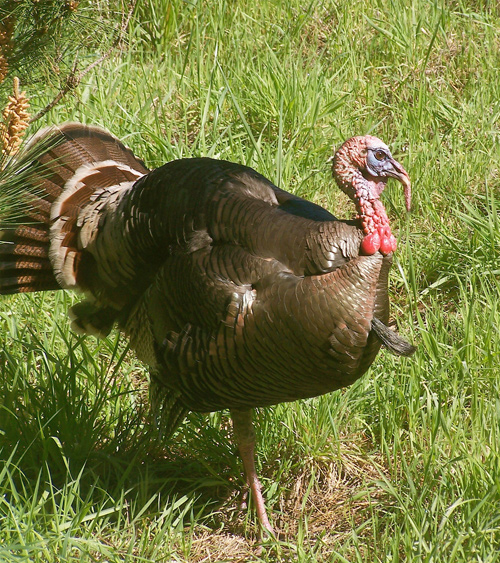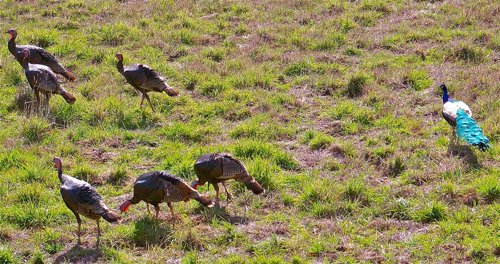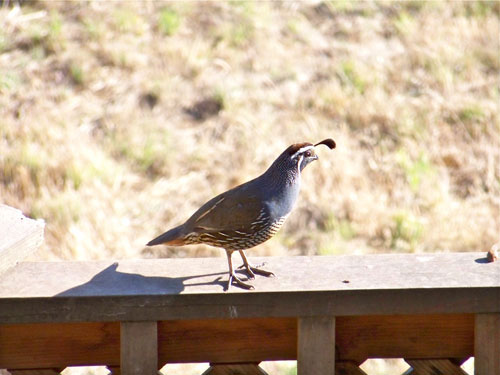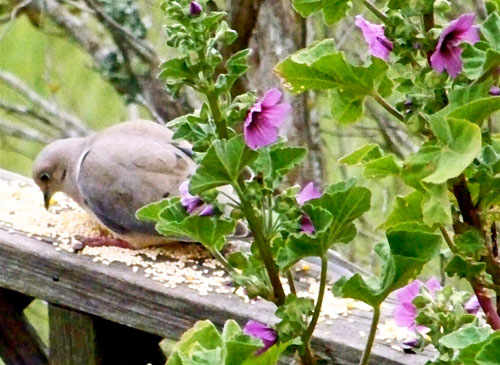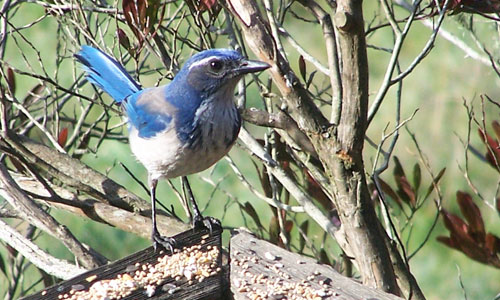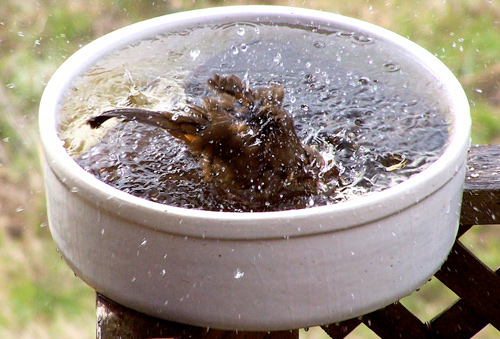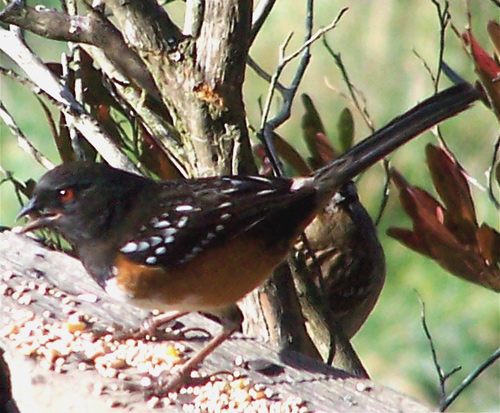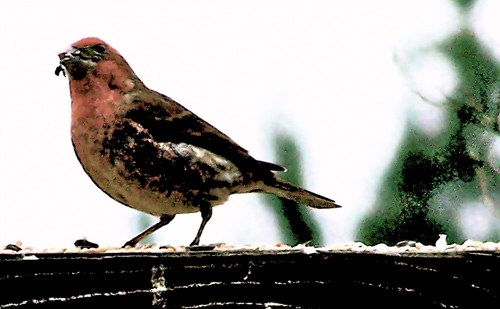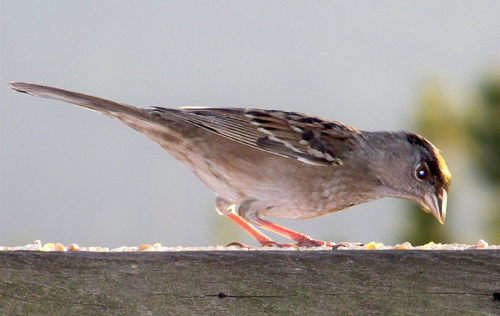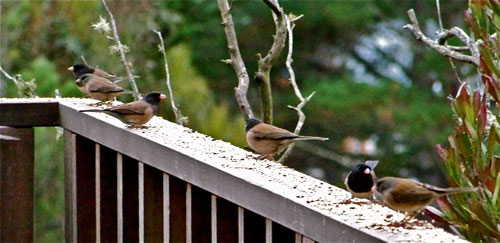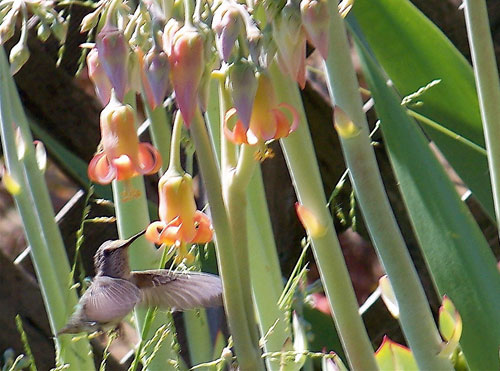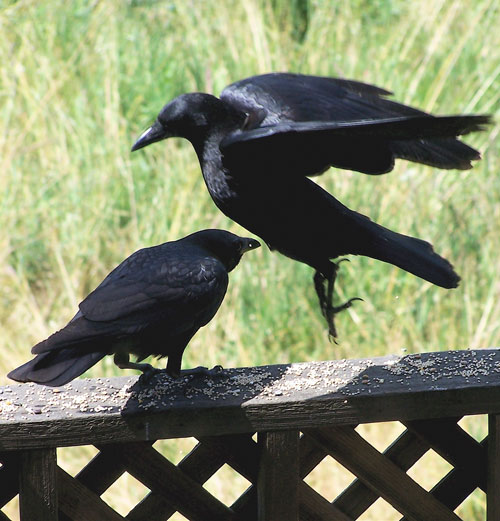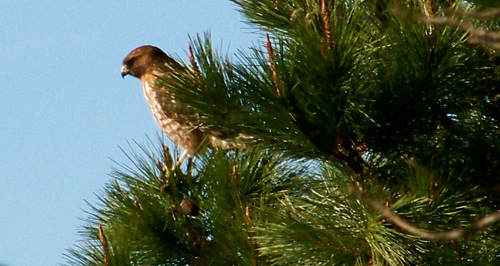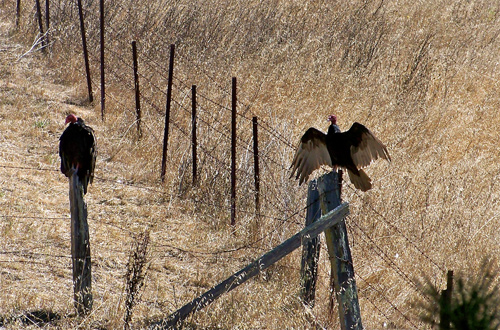Entries tagged with “Canada geese”.
Did you find what you wanted?
Mon 14 Feb 2022
Posted by DavidMitchell under General News, History, Photography, Wildlife
Comments Off on Happy Valentine’s Day & sorcery at the Nicasio PO
Caveat lectorem: When readers submit comments, they are asked if they want to receive an email alert with a link to new postings on this blog. A number of people have said they do. Thank you. The link is created the moment a posting goes online. Readers who find their way here through that link can see an updated version by simply clicking on the headline above the posting.

To ressurect one of my Valentine’s Day photos, I’ll start off with a skein of Canada geese flying past Inverness Ridge.
_______________________________________________
This posting is late because I’ve been grappling with interference from some hacker, who’s dropped hundreds of odd symbols seemingly at random in posts I recently put online and posts from years ago.
Some examples:
Journalist! [symbols disappeared]
Salvadoran [symbols disappeared]
the Gibson [symbols disappeared]
The author [symbols disappeared]
I suspect the hacker is Vietnamese since the symbols also show up in foreign-language comments, which Google identifies as Vietnamese.

____________________________________________________
The oddest West Marin news in the past fortnight came in the Feb. 3 Point Reyes Light. Here it is word for word.
Sheriff’s Call — Sunday, Jan.10:
NICASIO: At 7:42 p.m. a woman who said she was moving to town from Southern California reported that someone who works at the post office was shooting metaphorical arrows, meaning witchcraft and sorcery, and that God had told her she needed to eradicate witchcraft and sorcery. She said the man was going to make her have demonic serpent offspring and she could not report him to his supervisor because the supervisor was likely in the same region of warlocks, and she wanted to assure deputies that she had not been struck by the arrows because she was protected by the blood of Jesus — she had an X-ray to prove it.
When I showed this to a friend in San Rafael, what he found equally amazing is that tiny Nicasio has its own post office.
Fri 7 Jan 2022
Caveat lectorem: When readers submit comments, they are asked if they want to receive an email alert with a link to new postings on this blog. A number of people have said they do. Thank you. The link is created the moment a posting goes online. Readers who find their way here through that link can see an updated version by simply clicking on the headline above the posting.
This is a belated review of an entertaining linguistic book, A Charm of Goldfinches and Other Wild Gatherings. It was originally published five years ago by Ten-Speed Press. My wife Lynn gave it to me for Christmas. The author, Matt Sewell, is a Canadian ornithologist, illustrator, and artist who has exhibited in London, Manchester, New York, Tokyo, and Paris.

As most of us know, a group of geese is called a “gaggle” but if the geese are flying in formation, the proper term is “skein,” writes Sewell. The term “comes from an old French word for ‘V’ Formation.”

Some group names are grim but accurate. Here a “wake” of vultures divvy up a skunk killed by an owl.

Virtually every night at Mitchell cabin we can hear a “band” of coyotes howling.
Groups of coyotes are called “bands” although to my mind, “choirs” would be more accurate. Sewell notes that “outside of their guarded family units, coyotes hang together in unrelated gangs, scavenging and doing whatever coyotes do.”

A “sulk” of foxes atop a shed at Toby’s Feed Barn. These were spotted by postal staff outside a postoffice window.

A “plague” of rats. Given my recent experience with roof rats, I would second the group name “plague.” Roof rats found their way into my car’s engine compartment around Christmas and chewed wiring, piled up debris, and damaged the car’s computer. The final tab at garages in Point Reyes Staton and Santa Rosa to repair the damage came to more than $2,500.

A “trip” of rabbits.
Sewell frequently indulges his ironic sense of humor. Describing how groups of rabbits came to be called “trips,” Sewell writes: “Now, some of you may be thinking: the trip would be to follow the white rabbit down the rabbit hole. Â Sadly not: this term is from the 15th century, not the 1960s Jefferson Airplane lyric, or even Lewis Carroll’s Alice in Wonderland, which inspired the song. It is, in fact, about as psychedelic as a turnip patch.
“A colony of rabbits is a flighty bunch, not surprisingly, as the whole world is their enemy…. They are rarely safe for long, not when they’re hunted by hawks and owls, weasels, foxes, domestic pets, and humans, to name just a few.”
As noted previously, “jackrabbit” is short for “jackass rabbit,” a nickname it got because of its ears.
A “ lounge” of lizards. This is a blue-belly lizard on the wall of our cabin.
lounge” of lizards. This is a blue-belly lizard on the wall of our cabin.
Lizards are cold-blooded “so they need to warm up from the sun or on warm stones.”
“It’s this lounging that gets them into trouble though as lizards are easy prey in this laid-back state.
“If they are cruelly snatched, lizards at least have a last-gasp mechanism for freedom: they can release their tail, which will wriggle around in the predator’s mouth, confusing the daylights out of it while the lizard makes a dash for the undergrowth.”
I hope it gets there safely.
Tue 9 Feb 2021
Posted by DavidMitchell under Uncategorized
Comments Off on Humor to make Valentine’s Day on Sunday even happier

Happy Valentine’s Day from the Canada Geese at Mitchell cabin.
____________

The behavior of a crazed loser did not originate with Donald Trump, as this 1982 New Yorker cartoons illustrates.
_________

Formal debate had already begun replacing aggressive prosecution in another 1982 New Yorker cartoon. I had considered the gladiators-versus-lions in the Roman Coliseum the ultimate high-stakes event. It never occurred to me a lion might have to to impeach a histrionic gladiator who had overindulged his sense of entitlement.
_________

As noted here before, my obligation to encourage wildlife a few years back led me to teach this possum dining etiquette. You could safely invite him in for your Valentine’s Day dinner. He’s certainly no Covid-19 carrier.
_________

Is this a Senate committee hearing or just another hungry-and-thirsty American in search of sustenance?
_________

___________

__________

From a 1958 New Yorker
__________

As part of my program to refine wildlife, I once mentored a bodhisattva possum on its path to enlightenment.
__________

What was Edouard Manet picturing in Le Déjeuner sur l’herb’? Lunch on the grass.
__________

__________

And a hearty Happy Valentine’s Day! from the raccoon I’ve trained to work as a flower vendor and who, I might add, would be only too happy to provide the bouquet for your celebration.
I hope all this provided a ray of sunshine in these semi-dark times.
Fri 27 Nov 2020
Posted by DavidMitchell under Uncategorized
Comments Off on Falling into place
It’s been a generally good week in this old man’s world. Old is the operative word here. I turned 77 on Monday. My gait is increasingly unsteady, but I’m still carrying about 75 pounds of firewood uphill to Mitchell cabin each day. Lynn took me out for a birthday lunch at River Front Cafe’s outdoor tables beside the Petaluma River. A beautiful scene, and everyone maintained proper distancing. On Thursday, Lynn and I celebrated Thanksgiving, with Lynn’s preparing along with the turkey, homemade stuffing, her own cranberry sauce, and squash raviolis.
And while all this was going on, the fields around Mitchell cabin began turning from brown to green thanks to the rains two weeks ago.

The green shoots attract blacktail deer, and as many as eight at a time have begun showing up for the feast. For dessert, they often dine on persimmons that have fallen from our tree on the other side of the cabin.
The rains also eliminated any further risks of a flareup from the Woodward fire. The fire, which blackened 5,000 acres in the Point Reyes National Seashore beginning Aug. 18, has taken firefighters two months to fully control. The rains should have doused almost all smoldering ashes, the Park Service reported this past week.

Thanksgiving eve raccoon lineup on our deck.
A mother raccoon with her four kits show up outside our window every evening hoping to be fed, and we usually give them a few handfuls of dog kibble.
The raccoons around here appear to be thriving although further south around Muir Beach and inland to Mill Valley distemper has begun showing up in raccoons and foxes, WildCare warned this week. Coyotes and skunks, as well as domestic dogs, are also susceptible to the disease.
The organization noted, “Wild animals with distemper may exhibit a lack of coordination or balance, approachability, seizures, and/or discharge from eyes and nose….
“Concerned residents who see an animal in distress should call WildCare’s Living with Wildlife Hotline at 415-456-7283 or contact Marin Humane at 415-883-4621.”

Canada geese heading to Drakes Estero for the night fly over Mitchell cabin around sunset daily. They don’t wear masks, but they do maintain social distancing.

Also flying over head.
Something many of us said thanks for yesterday occurred in Washington. Donald Trump, who keeps denying he lost the Nov. 3 presidential election, finally said he will leave the White House by Jan. 20 if Democratic president-elect Joe Biden wins the electoral college vote on Dec. 14. Biden racked up 306 electoral college votes three weeks ago and needs only 270 to win. Trump in comparison picked up only 232 votes, which may account for his hair turning gray in the week after the election (see photo in Nov. 19 posting).
Wed 30 Oct 2019
Caveat lectorem: When readers submit comments, they are asked if they want to receive an email alert with a link to new postings on this blog. A number of people have said they do. Thank you. The link is created the moment a posting goes online. Readers who find their way here through that link can see an updated version by simply clicking on the headline above the posting.

On a normal evening, this is how Mitchell cabin’s sitting area, dining area, and kitchen look. A journalism student once described the scene as a collection of “mismatched furniture.”

But for three evenings this week, here is how it looked as seen from the other end of the room (thanks to an oil lamp and 11 candles) as a result of PG&E’s turning off power to West Marin, along with many other communities. It was a precaution against high winds that might knock down power lines and spark wildfires in this dry weather.
Although most of West Marin was spared unusually high winds, the blackout cost Mitchell cabin not only its lights but also its water pressure. During the blackout, water coming from our faucets was barely more than a trickle. The cabin’s elevation is close to that of the North Marin Water District tanks on Tank Road in Point Reyes Station. As a result, gravity alone doesn’t provide much of a flow in our household water system, so we rely on an electric pressure pump to have strong streams of water in faucets, hoses, and in the shower.
Nor were showers much of an option during the blackout for any townsperson with an electric hot water heater. With the power back, I finally got to take a shower this morning. If the blackout had gone on for too many more days, Point Reyes Station might have developed a stinky population.
As I write at 6 p.m. Wednesday, power is still off in parts of Dillon Beach, Fairfax, Kentfield, Marshall, Mill Valley, Muir Beach, San Anselmo, Sausalito, Stinson Beach, and Tomales, the Marin Sheriff’s Office has reported. Better wear a face mask when you visit folks there.

But even before the blackout began life here was seeming strange. I looked up from my living-room chair a few evenings ago and was startled to see this damsel outside peering in the window.

Once I thought about it, however, the explanation was obvious. I was seeing a reflection from part of a plant holder hanging inside near the window.

Canada geese heading west to Drakes Estero for the night one evening last week. I get to see them most evenings if I listen for their honking around sunset.

Memories of spring: a kestrel on the railing of our deck.
Dealing with the blackout has been tiring, so I’ll stop here and take a snooze. Goodnight. I’ll sleep tight. And I won’t have any bedbugs bite; after all, Mitchell cabin is not a Trump hotel.
Sun 8 Feb 2015
Posted by DavidMitchell under History
1 Comment
The middle of February is always a busy time in the United States and Canada, and this year it will be especially busy in Canada. Indigenous activists have announced plans for a one-day, coast-to-coast version of the Occupy movement. More about that in a moment.
Both countries will celebrate Valentine’s Day this Saturday, Feb. 14. President Abraham Lincoln’s birthday will be Thursday, Feb. 12, and President George Washington’s birthday will be Feb. 22. In accordance with Congress’ Uniform Monday Holiday Act of 1971, California and most other states will celebrate the two presidents’ birthdays together as Presidents’ Day this coming Monday, Feb. 16.
Beyond that, however, things fall apart; the center cannot hold, for the holiday never falls on Washington’s actual birthday although in some years it falls on Lincoln’s. In addition, some states honor different presidents with different holidays.
In Massachusetts and Virgina, only Washington’s birthday will be celebrated Monday. Massachusetts, however, will celebrate a second Presidents’ Day on May 29, honoring Presidents John F. Kennedy, John Adams, John Quincy Adams, and the lackluster Calvin Coolidge. Why those guys? They were all born in Massachusetts.
In Washington and Alabama, Washington’s and President Thomas Jefferson’s birthdays will be celebrated next week on Presidents’ Day but not Lincoln’s birthday. Arkansas on Monday will officially celebrate the birthdays of both Washington and Daisy Batson Gates (1914-99), an NAACP leader during the struggle for integration.
 The Big News this coming weekend, however, will concern neither Presidents’ Day nor Valentine’s Day.
The Big News this coming weekend, however, will concern neither Presidents’ Day nor Valentine’s Day.
Nor will it occur in the United States.
Just across the border, thousands of First Nation people plan to economically disrupt Canada for a day.
Canada geese over Point Reyes Station bring to mind two impending events: Valentine’s Day and #ShutDownCanada.
#ShutDownCanada, as it’s called, is a collection of nationwide protests being organized via Facebook, the Two Row Times of Hagersville, Ontario, reported on Jan. 21. The group is asking for communities across Canada to blockade their local railway, port or highway on February 13th,” the First Nation publication noted.
“Don’t buy, don’t fly, no work and keep the kids home from school.” The goal is to significantly impact the Canadian economy for a day and demand there be an independent inquiry into the 2000+ cases of missing or murdered indigenous women….
“Plans to demonstrate outside city halls, shut down highways, occupy high traffic areas and more have been organized by groups in Calgary, Espanola, Edmonton, Fredericton, Halifax, Hamilton, Kamloops, Lethbridge, London, Moncton, Montreal, Niagara, Oshawa, Ottawa, Regina, Toronto, Vancouver and Winnipeg.”
#ShutDownCanada intends to draw attention to both the “missing and murdered indigenous women” and to several “man-made environmental disasters [including] existing and operational fracking wells, open-pit mining projects, the Site C Dam construction [a hydroelectric dam planned in northeastern British Columbia], and the widespread devastation that tar sands and related pipeline projects brings to all life forms, ecosystems, families and communities.”
Drawing particular ire is the government of Prime Minister Stephen Harper, a Conservative. Percentage-wise, four times as many First Nation females as white females are being murdered or disappearing in Canada. So says a recent report from the Inter-American Commission on Human Rights, a branch of the Organization of American States.
 In December, however, Harper (at right in Canadian Broadcasting Corporation photo) shrugged off complaints that his government was not looking into the disproportionate number of attacks on indigenous women. “It isn’t really high on our radar, to be honest,” he acknowledged.
In December, however, Harper (at right in Canadian Broadcasting Corporation photo) shrugged off complaints that his government was not looking into the disproportionate number of attacks on indigenous women. “It isn’t really high on our radar, to be honest,” he acknowledged.
“Our ministers will continue to dialogue with those who are concerned about this…. I would rather spend my time focusing on what actions we can take to improve these situations, prevent these situations than have more multimillion dollar inquiries.”
Further offending many First Nation people were comments by Canada’s Minister of Aboriginal Affairs, Bernard Valcourt. When 16-year-old Rinelle Harper, who had been physically and sexually attacked, called for a national inquiry into the violence against indigenous females, he responded: “Listen, Rinelle, I have a lot of sympathy for your situation… and I guess that victims… have different views and we respect them.”
The First Nation reaction was immediate. Referring to the girl’s traumatic ordeal as a “situation” epitomized the insensitivity of the Harper government to indigenous people, one critic wrote.
Beyond fuming at the conservative government’s lack of concern about attacks on indigenous women, many First Nation people also accuse Harper of corruption, saying his government plans to take over more aboriginal land for development of natural resources in violation of a Canadian Supreme Court ruling.
In 1990, Mohawks in Quebec faced provincial and federal troops for six months in a standoff that resulted from a dispute over land ownership. Friday’s conflict will probably be more peaceable. An Eastern Door editorial by editor and publisher Steve Bonspiel, whom I wrote about last week, advised his Mohawk readers: “A unified approach without violence but with plenty of information to inform others is a sound one.”
Sun 18 Jan 2015
Here is a gallery of my bird photography, as was promised two weeks ago. The photos were all shot at Mitchell cabin or around it.

One reason Mitchell cabin gets quite a variety of birds and other wildlife is that its fields come within a few feet of a neighbor’s stockpond, where numerous creatures show up daily to drink or hunt. Here a common egret wades through shallow water, looking for frogs, small fish, or insects.

While it’s hunting, a great blue heron will repeatedly stand motionless and then use lightning-fast strikes with its sharp bill and long neck to catch gophers in Mitchell cabin’s fields or frogs and fish in the pond.

The cabin is under the commute route for Canada geese which travel daily between the Point Reyes National Seashore and the Marin French Cheese Factory’s ponds in Hicks Valley. It’s easy to tell when they’re coming; they honk as much as Homo sapiens commuters stuck in traffic.

A flock of tri-colored blackbirds swoop down onto the deck railing when Lynn or I spread a line of birdseed along it morning and evening. Many of the blackbirds nest in reeds at the pond.

Even after they’ve grown old enough to feed themselves, young blackbirds for awhile still want to be fed by their parents. Once in awhile the parents do oblige them, but over a few days, they wean their youngsters. (Photo by my partner Lynn Axelrod)

A tom turkey struts his stuff. In 1988, a hunting club working with the State Department of Fish and Game introduced non-native turkeys into West Marin on Loma Alta Ridge, which overlooks the San Geronimo Valley. By now there are far more turkeys than turkey hunters, and their flocks have spread throughout West Marin.

A little more than a year ago, a lone peacock showed up and soon began hanging out with a flock of wild turkeys. Months later, he can still be seen bringing up the rear as the flock hunts and pecks its way across the fields.

A male quail. Male and female quail both have crests. The males’ crests are black, the females, brown.

The Eurasian collared dove is a native of the Middle East that spread across Europe in the 20th Century, according to the Audubon Society. In 1974, it was accidentally introduced into the Bahamas. In the 1980s, the doves discovered the US was only a short flight away and began taking trips to Florida. In less than 30 years, the doves have spread throughout most of this country.

California western scrub jays show up immediately when we put seed on the railing.

A California towhee freshens up in the birdbath on the deck.

Rufous-sided towhees are among the most colorful birds that show up for birdseed.

A purple finch chews a sunflower seed it found among other seeds on the railing.

The presence of golden-crowned sparrows is often announced by their song, which sounds like Three Blind Mice in a minor key.

Oregon juncos keep a close eye on Mitchell cabin’s deck, and it’s never long after we put out birdseed that they begin showing up. They’re less skittish than most other birds and will sometimes begin pecking seeds off the railing before we’ve departed.

A female hummingbird. Hummingbirds drop by for drinks whenever we have flowers in bloom.

American crows, which are native to North America, are considered intelligent birds. Here, for example, they demonstrate their mastery of jitterbug.

A crow skins its caterpillar dinner in the birdbath.

Redtailed hawks dine on reptiles, small mammals, and birds. Their call is a two-or-three second scream which trails downward. Redtails are monogamous and typically reach sexual maturity at age two or three and can live to age 21 in the wild.

When I spotted this great-horned owl in a tree 200 feet or more from the cabin one evening, I decided to try photographing it. However, the light was so low that when I triggered the shutter, the little flash on my old-fashioned Kodak flipped open and fired. To my amazement, the flash was reflected in the owl’s eyes despite the bird’s distance from me. With eye shine (see tapetum lucidum) like that, it’s no wonder owls can see well in the dark.

Two buzzards warming themselves in the morning sun.
This gallery doesn’t include all the birdlife around Mitchell cabin, of course, but it’s a sampling of our avian neighbors. They’re not the only reason I enjoy living where I do, but they’re a big part of it.
Tags: American crow, buzzards, California western scrub jay, Canada geese, common egret, Eurasian collared dove, Golden-crowned sparrow, Great blue heron, great-horned owl, purple finch, quail, redtailed hawk, Rufous-sided towhee, towhee, Tricolored Blackbirds, wild turkeys
Sat 17 Sep 2011
Posted by DavidMitchell under West Marin nature, Wildlife
Comments Off on Incurring the raccoon gaze
What do you call a group of raccoons? They’re sometimes called a nursery, but the most common name is a gaze.

Three raccoon kits squeeze into the birdbath on my deck to clean their paws after eating.
 I’ve always been fond of raccoons, but I’m beginning to wonder if a surplus is developing around Mitchell cabin.
I’ve always been fond of raccoons, but I’m beginning to wonder if a surplus is developing around Mitchell cabin.
Of course, there are many raccoon tails in Marin County. The Marin Humane Society, for example, rescued a baby raccoon from a gutter’s drainpipe in the Hamilton area of Novato Thursday afternoon.
The trapped raccoon was discovered by children who heard its cries, The Marin Independent Journal and Bay City News both reported.
It took animal control officers, who used a plumbing camera, two hours to locate the approximately month-old raccoon and then pull it out to safety.
The baby raccoon is now at the WildCare wildlife rehabilitation center in San Rafael.
Here eight raccoons, two mothers, each with three kits, dine on honey-roasted peanuts on my deck. A ninth raccoon, a solitary male adult, will show up after this gaze has left.

Possums are found throughout West Marin wherever ponds, creeks, marshes, and even drainage ditches provide riparian habitat. West Marin’s possums originated in the Deep South where “common opossums” are commonly called possums, thanks to a linguistic phenomenon known as aphesis. Calling mosquitoes “skeeters” is another example of aphesis.
“The common opossum,” writes Point Reyes Station biologist Jules Evens in The Natural History of the Point Reyes Peninsula, is “the only marsupial native to North America [but] is not native to Point Reyes or the Pacific Coast. After the first known introduction into California at San Jose about 1900 (for meat, delicious with sweet potatoes), opossums spread rapidly southward: by 1931 they were common on the coastal slope from San Francisco Bay south to the Mexican border. Point Reyes avoided the onslaught until about 1968.”

Another introduced species often found in the fields next to Mitchell cabin, Equus caballus.
They’re called Arabians in the sign on the pasture gate, but I doubt a one of them has ever seen the Mediterranean. This being the Far West, “cayuse” (rhymes with “dye use”) would seem more appropriate. Surely you remember Willie Nelson singing Don’t Fence Me In: “On my cayuse let me wander over yonder/Till I see the mountain rise.”
“Cayuse” in reference to a horse comes from the name of the Cayuse people of the Pacific Northwest. Sort of like Belgian referring to both a people and a chestnut-colored draft horse.

Canada geese flying over the hill behind Mitchell cabin.
Hundreds of Canada geese winter annually on Tomales Bay, on Nicasio Reservoir, and at Bolinas Lagoon. Along with these snowbirders, a year-round population of Canada geese is developing in West Marin.
Many of the year-rounders are descendants of geese that people with a surplus goose or two dropped off at the pond in front of the Cheese Factory on the Point Reyes-Petaluma Road, beginning back in the 1970s.
Mon 11 Oct 2010
The most recent wildlife adventures around my cabin began three weeks ago when I started down my driveway to pick up the morning Chronicle. There in the dirt at the edge of my parking area were several large paw prints, too large for the critters I usually see around here. Roughly 25 feet away, other tracks showed where a deer had kicked up dirt as it ran off.
A check of my tracking guide confirmed a mountain lion had probably been on my property the night before. That was an exciting but not altogether surprising discovery, for I’ve heard reports of mountain lion sightings along Tomasini Canyon Road, the next road to the north.

A gray fox eating bread on my deck.
With so much wildlife on this hill, my cabin has become a sort of blind for observing it.

In the past week, up to three foxes at a time have shown up on my deck. I sometimes feed them a few pieces of bread or a few peanuts, but judging from their scat, with which they mark my property (including the roof of my car), their main diet these days is blackberries.

On several occasions, I’ve watched encounters on my deck between raccoons and a fox. Neither seemed overly alarmed by the other, and at times the fox approached a raccoon within a few feet.
This is not to say that no other wildlife alarms raccoons. One kit sprang onto a post of the deck railing tonight and was about to climb to the top when suddenly it froze and flattened itself against the lattice.
For half a minute it hung there with only its head peeking over the top. Eventually the kit climbed on top of the railing, paced back and forth, but went nowhere. About this time, a couple of deer walked by just beyond the railing. Only when they were gone did the kit feel free to resume its meandering.

The foxes, however, seem not to be alarmed by any creature around my cabin. Sunday night when I scattered some tortilla chips on the deck and left the door open, this fox was curious enough about my kitchen to look inside before chowing down on the chips.

The foxes are usually skittish enough to run off a few feet when I open the kitchen door, but they quickly return.
And twice when my friend Lynn Axelrod stuck a piece of bread out the door, a fox took it from her hand.

Three, four, and even five raccoons have shown up simultaneously on my deck in the last week. They too enjoy snacking on bread, but except for one older male, they enjoy peanuts even more.
I occasionally put out a few handfuls of honey-roasted peanuts for their dessert, and I’ve had raccoon kits so enthusiastic that on occasion they grabbed my hand with their paws before I was done. Very odd to shake hands with a raccoon. Thank God they grabbed with their paws and not their teeth.
Because raccoons use their paws in eating, they wash them in my birdbath afterward, as well as take long drinks, no doubt thirsty from the salty peanuts.

Also taking advantage of my birdbath is this pine siskin.

A pine siskin swoops down to join five other siskins eating birdseed on the railing of my deck.
Pine siskins are an irruptive species, meaning that their populations can increase rapidly and irregularly. A type of finch, they are particularly plentiful this year because their main source of food, seeds, is also plentiful.
Also enjoying birdseed on my deck are roof rats, which on some evenings show up even before the birds leave.
There are noticeable variations in coloring among roof rats, with the one on the right demonstrating why they’re sometimes called black rats. I’ve written quite a bit about roof rats previously, and I won’t repeat it all here.

Canada geese fly over my cabin almost every evening. I always know by their honking when they’re coming. Some evenings several flocks in a row will head west overhead. Naturally a migratory bird, the geese used to only winter here, but in recent years West Marin has developed a large year-round population.
Also announcing themselves around my cabin these nights (in fact, I hear their yips and howls right now) are a number of coyotes. Like the gray foxes, coyotes are members of the dog family, canidae. However, unlike gray foxes, they can’t climb trees, which is a blessing for us all.




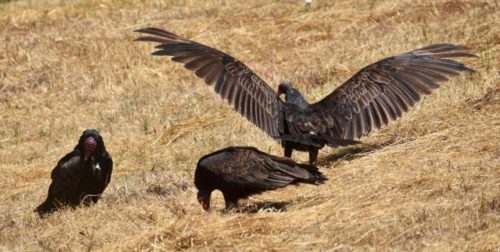
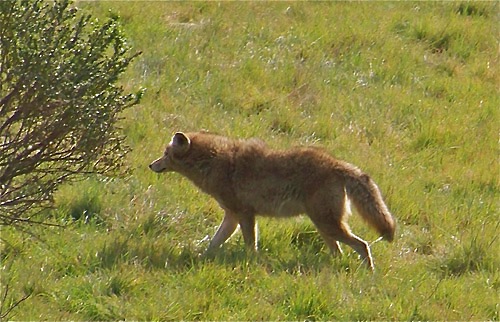
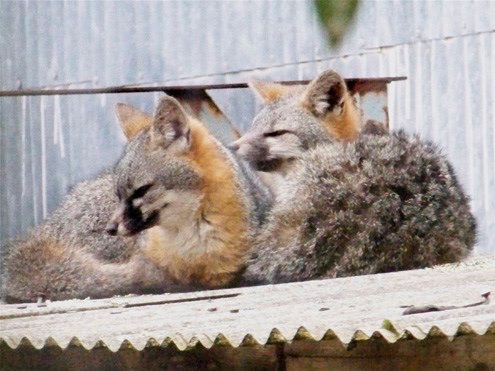
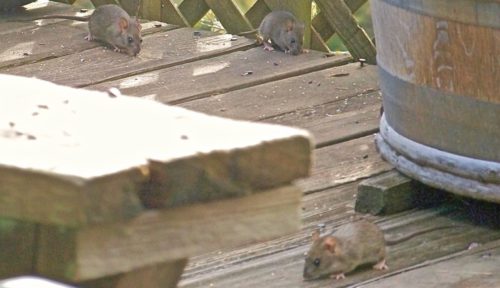
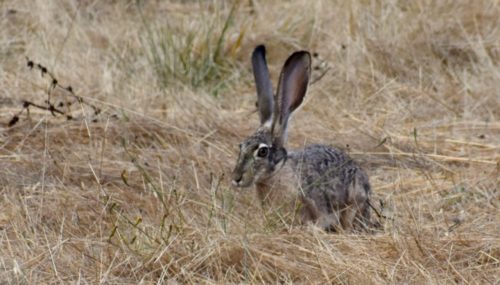
 lounge” of lizards. This is a blue-belly lizard on the wall of our cabin.
lounge” of lizards. This is a blue-belly lizard on the wall of our cabin.




